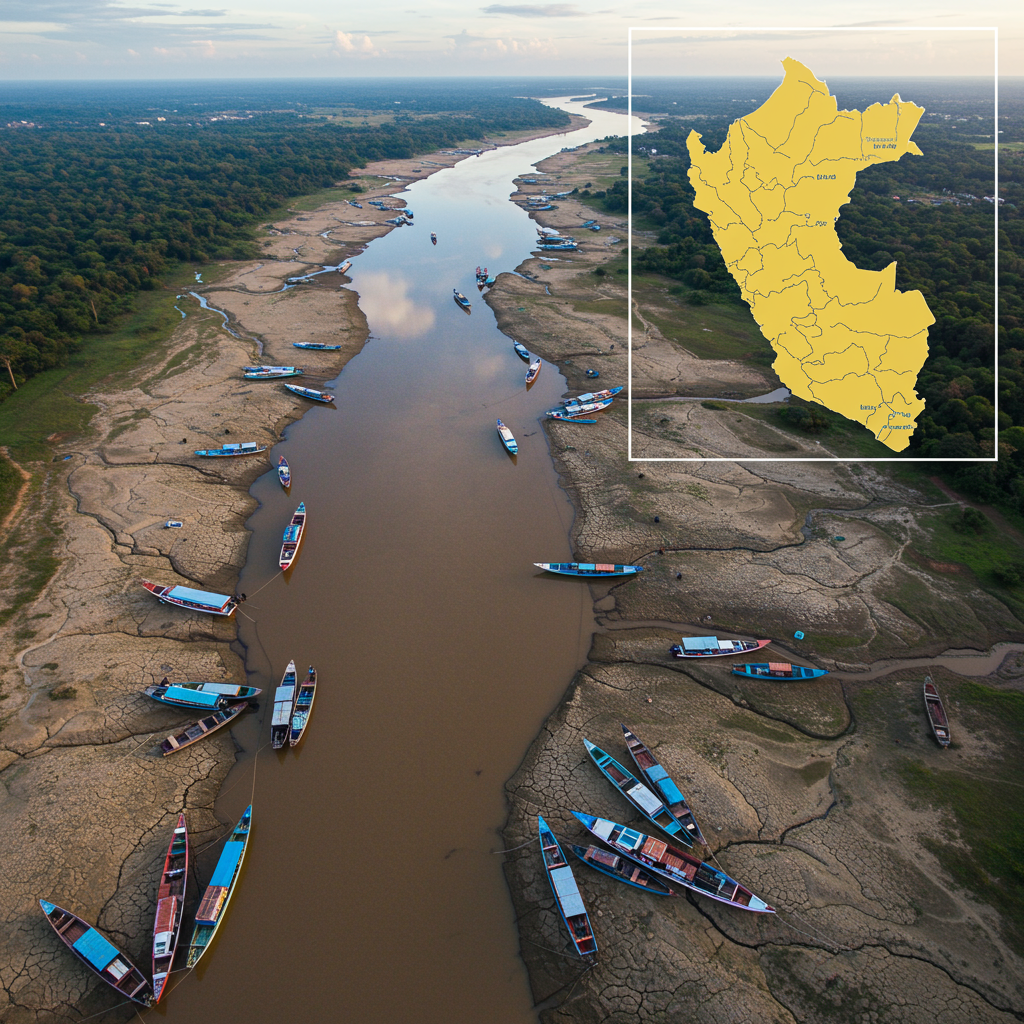Colombia’s only gateway to the vast Amazon River, the remote town of Leticia, faces an urgent and multifaceted crisis. A natural phenomenon — the Amazon River’s gradual shift — threatens to leave this vital port landlocked. This environmental challenge has ignited a simmering geopolitical dispute with neighboring Peru, exacerbating the region’s already complex dynamics. The very survival of Leticia and its 55,000 residents hinges on the unpredictable currents of the world’s second-largest river and the delicate balance of international diplomacy.
Colombia’s Amazon Gateway Under Existential Threat
Leticia, strategically positioned at Colombia’s southernmost tip, serves as the nation’s sole access point to the Amazon. However, this unique lifeline is now in jeopardy. Studies by the Colombian Navy predict a grim future: within five years, Leticia could become entirely cut off from the main river channel, effectively landlocking the bustling port. This alarming prospect stems from a combination of natural forces that are reshaping the Amazon’s course.
Drought, persistent sedimentation, and the river’s natural meandering are gradually pushing the main waterway southward into Peruvian territory. This slow but relentless geographical transformation poses an existential threat to Leticia. The town, despite having an airport, lacks any direct highway connections to other regions of Colombia. Its very existence, including the flow of essential food and supplies, relies almost entirely on river transport from Peru and Brazil.
The Economic Lifeline: A Precarious Dependence
For the residents of Leticia, the Amazon is more than just a river; it is their economic heartbeat. Biology professor Santiago Duque from Colombia’s National University in Leticia underscores this critical dependence. “We depend on daily trade between the three countries to survive,” Duque states, emphasizing the river’s indispensable role. The area, famously known as the “triple frontier,” sees a constant flow of tourists, traders, and boat pilots from Colombia, Peru, and Brazil. This vibrant cultural exchange, where locals often quip about breakfasting in Colombia, lunching in Peru, and dining in Brazil, is now under severe strain.
The receding river has already caused significant logistical nightmares. Leticia’s cargo wharf has undergone multiple extensions in a desperate attempt to reach the dwindling water levels. During dry seasons, however, the wharf sits on parched land, rendering forklifts and other machinery useless. This forces workers to revert to manual labor. Sweaty teams unload cargo boats by hand, shouldering heavy crates of beer, sacks of rice, and bags of flour. They trudge 100 yards up muddy riverbanks to waiting trucks. This arduous process not only slows trade considerably but also drives up crucial costs for everything. Local businessman Sigifredo Beltrán grimly compares the situation to “going back to the 18th century.”
A Tiny Island Ignites a Geopolitical Flashpoint
The environmental crisis gripping Leticia has unfortunately converged with a long-standing border dispute, escalating tensions between Colombia and Peru. The flashpoint is Santa Rosa, a small island formed in 1974, situated just a few hundred yards from Leticia in the Amazon River. While the 1922 treaty established the Peru-Colombia border, Santa Rosa was never formally allocated. Despite being home to approximately 3,000 Peruvians, Colombia also asserts its claim to the island.
The dispute flared in July when Peru’s congress unilaterally upgraded Santa Rosa’s administrative status from a village to a town, granting it a larger government presence. This move provoked a swift and strong reaction from Colombia. President Gustavo Petro flew to Leticia to protest, explicitly stating, “Colombia does not recognize Peruvian sovereignty over Santa Rosa.” The situation further intensified with a dramatic act by Colombian presidential candidate Daniel Quintero. He posted a video of himself clandestinely raising a Colombian flag on Santa Rosa, declaring it “Colombian territory.” Peruvian authorities promptly removed the flag within 15 minutes.
Historical Echoes of Border Tensions
Such displays of nationalist sentiment are not new in Colombian politics, often used to rally public support around sensitive territorial issues. Historically, Colombia has grappled with significant border disputes, the most infamous being the loss of Panama. In 1903, the U.S. government fomented a revolution there to build the Panama Canal, severing it from Colombia. This historical context underscores the deep sensitivity around territorial integrity for Colombians.
Indeed, Colombia and Peru have a history of contention over their shared frontier. Leticia itself was established by the Peruvian military in the 1800s. It later switched hands, granting Colombia vital access to the Amazon River. However, Peruvian protests led to a brief but fierce border war between the two nations in 1932. These past conflicts highlight the long-standing complexities that underpin the current dispute over Santa Rosa Island.
International Law Weighs In: Defining Riverine Borders
The legal complexities surrounding Santa Rosa are significant, with experts suggesting both nations hold legitimate claims. Walter Arévalo, an international law professor at Rosario University in Bogotá, provides crucial insight. The 1922 border treaty dictates that the deepest channel of the Amazon River defines the frontier, with Colombia to the north and Peru to the south. When Santa Rosa initially formed, the deepest channel ran north of the island, which would support Peru’s claim.
However, the river has since shifted and divided. Now, a smaller branch of the Amazon flows past Leticia, and its deepest channel runs south of Santa Rosa. This new geographical reality strengthens Colombia’s assertion of sovereignty over the island. Arévalo emphasizes that disputes over riverine borders are common globally, citing the example of Belgium and the Netherlands. These European nations hold regular discussions to address newly formed islands and course changes in the Meuse River, which forms part of their border. Arévalo advocates for Colombia and Peru to adopt a similar collaborative approach, stating, “The ideal situation would be for both countries to take full advantage of the river.”
Colombia’s Neglected Frontier: A Call for Action
A critical factor contributing to Leticia’s current predicament is what many see as decades of neglect by Colombian officials. The impending threat of a landlocked Leticia could have been mitigated. Dredging the smaller branch of the Amazon River that flows past the town might have preserved its access. However, such dredging operations are expensive. Professor Duque attributes this long-standing inaction to the region’s sparse population. He suggests that Colombian politicians often pay little attention to this remote area, which is far from the country’s main population centers and political hubs.
Despite the political rhetoric and escalating official disputes, the local communities on both sides of the border maintain strong, interdependent ties. Residents of Santa Rosa, though proudly Peruvian and displaying a large red-and-white flag, frequently cross into the larger Leticia for essential services. Hotel manager Iván Yovera notes that islanders often shop, send their children to school, and receive medical care in Leticia. Fisherwoman Flor Gómez echoes this sentiment, leaning from her wooden balcony: “We’ve never had problems” with Colombia, adding, “We are like brothers.” Max Ortiz, Santa Rosa’s acting mayor, recognizes that such border disputes are likely to recur due to the Amazon’s “ever-changing flow,” simply attributing it to “Mother Nature.”
Amidst the growing tensions, a bilateral border commission between Colombia and Peru, which had been dormant for years, has reactivated. Meetings are scheduled for September 11 and 12 in Lima, the Peruvian capital. This diplomatic channel offers a crucial opportunity to de-escalate the situation and collectively address the complex environmental and geopolitical challenges facing the Amazon’s triple frontier. The future of Leticia, its vital river access, and the stability of this unique border region depend on these crucial negotiations.
Frequently Asked Questions
What are the main threats to Leticia’s river access and economy?
Leticia, Colombia’s sole Amazon port, faces an existential threat primarily from the Amazon River’s changing course. Drought, significant sedimentation, and the river’s natural meandering are gradually pushing the main channel south into Peru. A Colombian Navy study predicts Leticia could be landlocked within five years. This directly impacts the town’s economy, as it relies almost entirely on river-based trade from Peru and Brazil for supplies, lacking highway connections to the rest of Colombia. Manual cargo unloading, increased costs, and slowed trade are already significant disruptions.
What is the significance of Santa Rosa Island in the Colombia-Peru dispute?
Santa Rosa is a small island in the Amazon River, located near Leticia, which has become the focal point of a border dispute. Formed in 1974, it was never formally allocated despite the 1922 border treaty. While 3,000 Peruvians reside there, Colombia also claims the island. The dispute escalated when Peru upgraded Santa Rosa’s administrative status, prompting strong protests from Colombia’s President Gustavo Petro and even a flag-raising “stunt” by a presidential candidate. The island’s claim is complicated by shifts in the Amazon’s “deepest channel,” which, according to the 1922 treaty, defines the border.
What steps are being taken to resolve the Colombia-Peru border dispute and Leticia’s crisis?
To address the escalating tensions, a previously dormant bilateral border commission between Colombia and Peru has been reactivated. Meetings are scheduled for September 11 and 12 in Lima, Peru’s capital, aiming to find a diplomatic resolution. While dredging the smaller Amazon branch near Leticia could have prevented the town’s landlocked fate, it was not undertaken due to expense and the region’s sparse population. The commission’s discussions represent a crucial opportunity for both nations to collaborate on managing the changing riverine border and securing Leticia’s future access to the Amazon.
Conclusion: Navigating a Complex Future
The challenges confronting Leticia, Colombia, encapsulate a broader narrative of environmental change, economic vulnerability, and persistent geopolitical tensions in the Amazon basin. The drying river threatens to sever Leticia’s essential lifeline, while the dispute over Santa Rosa Island highlights the enduring complexities of riverine borders and historical grievances. As the bilateral commission convenes, the world watches to see if diplomacy can forge a path forward. The outcome will not only determine the fate of Colombia’s vital Amazonian port but also serve as a crucial test of regional cooperation in the face of nature’s relentless transformation. Understanding these interwoven challenges is key to appreciating the delicate balance in this unique triple frontier.




